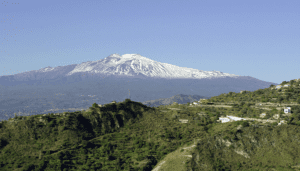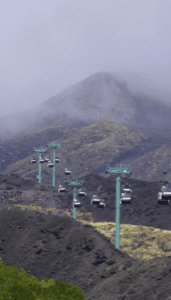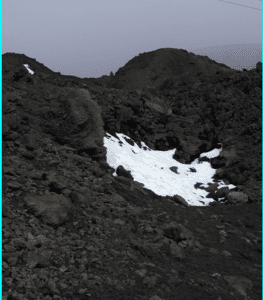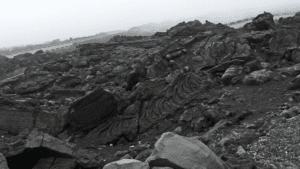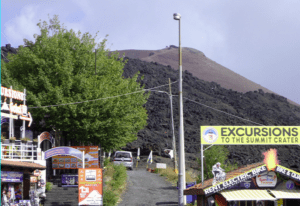This was supposed to be the highlight of our last day in Sicily. We had had a glorious week of blue skies and wall to wall sunshine, but the last day let us down badly. We woke to a dull and damp morning with Etna shrouded in mist. I’ve only given this a 3* rating because of the weather. On a good day it would definitely be a 5*.
Knowing the forecast for our last day was going to be iffy, it is a pity that Riviera Travel didn’t swap the Etna day to the previous day or delay until the afternoon to give the cloud and rain time to clear.
Standing at 3329m, Mount Etna dominates the the view in the eastern part of the island. It is Italy’s highest mountain south of the Alps.
Mount Etna is the largest active volcano in Europe in an almost constant state of activity. Eruptions occur frequently from the four summit craters and also from the fissures and old side craters on the mountain’s flanks. Volcanic and seismic activity is closely monitored by 120 seismic stations and satellites and there may times when the summit is closed to visitors.
Activity first appeared around 500,000 years ago with eruptions occurring beneath the sea. By around 35,000 years ago a volcano had appeared. The Greeks believed that Vulcan, god of fire and metalwork had his workshop here. Roman records from 122BC describe a massive eruption that blocked the sun for several days and caused widespread damage.
There were other devastating eruptions in 1381 and 1669. In 1669, lava flows destroyed 16 towns and engulfed a lot of Catania, killing 12,000 people. The most recent devastating eruption was in 1928 when the villages of Cerro and Mascali were destroyed. A violent eruption in 2007 threw up a 400m cloud of ash resulting in the closure of Catania airport.
Eruptions in centre crater are rare but are frequent from the side vents where they form secondary craters. Remains of numerous ancient vents can be seen around the volcano as well as the old lava flows. These eventually weather into very fertile soil which can be used for growing almonds, olives, grapes, citrus fruits and vegetables below 1000m.
Oaks and chestnuts are found on the lowest slopes with birch, beech, larch and black pine higher up. The yellow flowered broom found growing along the sides of the road is native to Etna. Above the tree line, grasses and lichens flourish
We drove up to the first tourist area on the south side of the volcano at around 2000m, with its shops, restaurants and cafes. This was cold and misty when we arrived. There are two secondary craters here and lots of black basalt lava flows. A cable car ascends to the second level at 2500m where there is a shop (which rents out warm jackets and boots) and small cafe and more secondary craters. The trip takes 20 minutes, and with five other members of the group, I took this up to an area covered with black basalt lava flows with patches of snow on the ground.We were in the clouds with the mist swirling around us.
From here, Unimog buses continue up to 2920m and are met by guides who accompany tourists to the edge of the crater. The cloud was still well down and we were unable to see the top of Etna or back down to the lower flanks. It was generally agreed there was little point in going any further up the volcano.
By the time we got on the coach back to Taormina, the cloud was beginning to clear off the lower slopes and the sun was trying to shine.
Frustratingly, the time the coach got back to Taormina, the cloud had cleared and Etna was again in the sunshine….
There are more pictures “here”:http://wasleys.org.uk/eleanor/otherholidays/sicily/day_seven/seven_one/index.html and full details of the whole holiday
“here.”:http://wasleys.org.uk/eleanor/otherholidays/sicily/index.html
